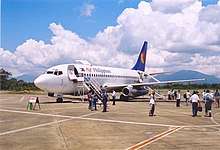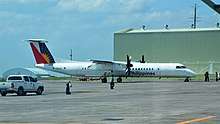PAL Express
PAL Express,[1] legally known as Air Philippines Corporation and formerly branded as Air Philippines and Airphil Express, is a subsidiary airline under the ownership of Philippine Airlines. It is PAL's regional division, with services from its hubs in Manila, Clark, Cebu and Davao.
| |||||||
| Founded | February 13, 1995 (as Air Philippines) | ||||||
|---|---|---|---|---|---|---|---|
| Hubs | Ninoy Aquino International Airport (Manila) | ||||||
| Secondary hubs |
| ||||||
| Frequent-flyer program | Mabuhay Miles | ||||||
| Fleet size | 30 | ||||||
| Destinations | 36 | ||||||
| Parent company | Philippine Airlines | ||||||
| Headquarters | R1 Hangar, Andrews Avenue, Nichols, Pasay City | ||||||
| Key people |
| ||||||
| Website | www | ||||||
The airline has been re-branded a number of times, first as Air Philippines, then Airphil Express, and is now known as PAL Express. After a series of financial losses, Air Philippines ceased operations until it was acquired by investors from Philippine Airlines. After the acquisition, the airline was re-launched as PAL Express, operating some routes and slot assignments of its sister company Philippine Airlines until its management decided to re-brand the carrier as a budget airline known as Airphil Express. However, in March 2013, the company's CEO announced that the name would be reverted to PAL Express. As a codeshare partner of Philippine Airlines, PAL Express operates as a full service carrier within a low-cost model.[2]
PAL Express is Philippine Airlines' answer to Cebu Pacific's dominance in the low-cost travel market in the Philippines. It has allowed PAL to focus on the premium market, where PAL does not have competition among other airlines. PAL Express gained a significant increase in passengers following its launch as a low-cost carrier. The airline is currently in fleet acquisition mode[3] to support its regional route expansion plan. PAL Express currently holds the no. 3 position among Philippine-based airlines, with 19% market share.[3]
History
Beginnings as Air Philippines (1995-1999)

Air Philippines was incorporated on February 13, 1995, with the base of operations being the former Naval Air Station Cubi Point. Flight operations started on February 1, 1996, with a Boeing 737-200 between Subic Bay, Iloilo, and Zamboanga. In 1996 six NAMC YS-11 and four Boeing 737-200 aircraft were acquired by the company. In 1997 an additional one Boeing 737-200 was acquired. In this same year, the airline carried over 675,000 passengers and over 773,000 in 1998. In September 1998 the airline was temporarily grounded by the Philippine Air Transportation Office but was reactivated when U-Land agreed to purchase a stake.
Lucio Tan Group takeover (1999-2008)
It was in 1999 when Lucio Tan Group took over management of the airline. In March 1999, Air Philippines was granted approval to operate international services to Hong Kong, Japan, South Korea, Taiwan, and the USA. In May 2001 two Boeing 737-300 aircraft were delivered. In mid-2002, charter flights were started from Subic Bay and Laoag City to Hong Kong. Passenger numbers carried rose to nearly 881,000 in 2002. In July 2004 charter flights started from Subic Bay to Guangzhou.[4]
Air Philippines significantly increased ties with Philippine Airlines (PAL), including the merging of frequent flier plans, timetables, and ticket sales. Air Philippines also moved into the PAL terminal at the Ninoy Aquino International Airport (Manila). Some of PAL's major stock owners are also owners of Air Philippines. Air Philippines officially ceased to be part of Philippine Airlines' frequent flier program, "Mabuhay Miles", on October 1, 2007.[5] Air Philippines has said that they chose to back out of the Mabuhay Miles program to benefit their passengers, so rather than flying numerous flights to gain miles and wait to a certain point to receive bonuses, passengers can benefit with lower fares and more discounts with quicker bonuses, much more like today's modern-day low-cost airline.
PAL Express launch (2008-2010)
On April 10, 2008, Philippine Airlines announced an order for aircraft for the PAL Express fleet. It consisted of aircraft from the Bombardier Q family, including three from the Q300 series and six from the Q400 series, manufactured by Bombardier Aerospace in a deal valued at $150 million.[6] PAL announced on April 13 that the new fleet would be based mainly in Cebu City to serve regional routes, while flights from Manila would also be launched.[4]
PAL Express was unveiled on April 14, 2008. The airline primarily flies intra-regional routes from its Cebu hub to the Visayas and Mindanao islands, as well as secondary routes to smaller airports in island provinces that are not able to accommodate PAL's mainline jet aircraft.[5] On May 5, 2008, PAL Express began operations by launching flights to Malay.[7] The airline on the same day announced it would serve 22 inter-island routes, including some provincial points that were without air service.[8] Flights out of Cebu City commenced on May 19, 2008. On July 1, 2009, PAL Express flights became eligible for Mabuhay Miles. After Air Philippines ceased operations on August 31, 2009, they transferred all their flights to PAL Express.
Rebranding to Airphil Express (2010-2012)

.jpg)
PAL Express was rebranded as Airphil Express on March 28, 2010. The airline restored jet service to Iloilo, Bacolod, Puerto Princesa and Cagayan de Oro, utilizing Airbus A320 aircraft flying under the Airphil Express banner on March 28, 2010.[9][10] The airline subsequently operated eight Bombardier Aerospace turboprop aircraft and two new Airbus A320s, all of which were former Philippine Airlines aircraft.
In January and early February 2012, GE Capital Aviation Services Limited (GECAS) announced the delivery of three new Airbus A320 aircraft to Airphil Express to help the carrier expand its fleet.[11] On October 28, 2012, Airphil Express resumed "Mabuhay Miles" for passenger to earn and redeem their miles on any Airphil Express and Philippine Airlines.
Reversion to PAL Express and codeshare with PAL (2014-present)
In the first quarter of 2013, Airphil Express announced its new route from Zamboanga to Sandakan, Malaysia. In May 2013, PAL Express was forced to cancel flights due to the 2013 Lahad Datu standoff. On March 15, 2013, Airphil Express reverted its name to PAL Express using the familiar "sunriser" PAL livery and logo on its tail and fuselage while maintaining its business name as Air Philippines Corporation.[2]
As of March 2014, PAL Express began carrying the brand name Philippine Airlines through a cooperative agreement with PAL. This strategy is intended to harmonize the two carriers in order to make them more competitive, ensure leadership and superior core services, and enhance the efficiency and profitability of both carriers.
In 2016, the airline signed a letter of intent with Bombardier for orders of up to 12 Bombardier Dash 8-Q400 aircraft in a two-class 86-seat configuration.[12] On December 16, 2016, PAL Express began its Caticlan, Busuanga and Basco services from its Clark hub. These alternate route operations were launched to decongest traffic on their Manila hub.
Destinations
Fleet

The PAL Express fleet consists of the following aircraft:[13]
| Aircraft | In Service | Orders | B | PE | E | Total | Notes |
| Airbus A320-200 | 12 | — | 12 | — | 144 | 156 | 5 aircraft in 180-seat configuration and 7 aircraft in 156-seat configuration. |
| — | 12 | 168 | 180 | ||||
| Airbus A321-200 | 6 | — | 12 | 18 | 169 | 199 | All 6 aircraft transferred from Philippine Airlines mainline fleet. |
| Bombardier Q400 NextGen | 12 | — | — | 6 | 80 | 86 | |
| Total | 30 | — | |||||
|---|---|---|---|---|---|---|---|
Former fleet
| Aircraft | Replaced by |
|---|---|
| Airbus A330-300 | Returned to parent company Philippine Airlines. |
| Boeing 737-200 | Airbus A320/Airbus A321 |
| Boeing 737-300 | Airbus A320/Airbus A321 |
| Bombardier Q300 | Bombardier Q400 NextGen |
| Bombardier Q400 | Bombardier Q400 NextGen |
| McDonnell Douglas MD-82 | Airbus A320/Airbus A321 |
| NAMC YS-11 | Bombardier Q400 NextGen |
In Popular Culture
- An Air Philippines 737-200 was featured in the Korean Drama, Reply 1997's, intro.[14]
Incidents and accidents
- On June 24, 1996, an Air Philippines YS-11 aircraft struck a ground power unit while taxiing at Naga Airport (WNP). The aircraft caught fire. There were no fatalities among the 34 aircraft occupants.
- On April 19, 2000, a Boeing 737-200 jet operating as Air Philippines Flight 541 from Manila to Davao, had 131 people killed midway due to the crash before the approach at Francisco Bangoy International Airport. It was the most fatal accident of the airline and the worst aviation disaster in Philippine history.
- On August 11, 2008, a Bombardier DHC-8 Q400 aircraft operating as Airphil Express Flight PR29 with 75 passengers and 3 crew, had safely landed on runway 04 at Catarman Airport when the airplane's nosewheel struck a soft spot in the runway's surface during taxi, the airline reported. No injuries were reported.[15]
- On November 15, 2008, another Bombardier DHC-8 Q400 operating as Airphil Express Flight PR272, made an emergency landing at its destination, Davao International Airport, from Zamboanga International Airport due to a problem with the plane's left landing gear. No one onboard was injured and the aircraft landed safely.
- On February 13, 2012, an Airbus A320 operating as Airphil Express Flight 969 with 135 people on board, overshot the runway at Kalibo International Airport, Kalibo, Aklan. No injuries or aircraft damage occurred in the incident.
- On April 23, 2012, a Bombardier DHC-8 Q400 flight from Zamboanga City to Tawi-Tawi was aborted as smoke emitted from the right turboprop engine of the plane. The plane was about to take off when pilots noticed the smoke, prompting them to return to the ramp and order 50 passengers to disembark shortly after 7:00 in the morning. There were no injuries reported.
References
- "Air Philippines Corp. doing business under the name and style of Airphil Express; PAL express; and Philippine Airlines - GENERAL CONDITIONS OF CARRIAGE" (PDF). philippineairlines.com. Archived (PDF) from the original on April 18, 2018. Retrieved April 18, 2018.
- "Page or Link has Expired". www.philippineairlines.com. Archived from the original on March 17, 2013.
- airphil express (2011-06-14). "EXPRESSions on air: Airphil Express now fastest-growing carrier, grabs 19% market share". Airphilexpress.blogspot.com. Archived from the original on 2014-08-14. Retrieved 2013-08-24.
- "PAL to reopen Cebu hub for turbo-prop flights". Air Transport News. Archived from the original on 20 August 2016. Retrieved 15 July 2016.
- "About Us". PALexpressair.com. Archived from the original on 2009-09-26. Retrieved 2013-09-26.
- Romy, Sabaldan. "PAL's revived inter-island operations to perk up domestic tourism". PIA Archive News Reader. Philippine Information Agency. Archived from the original on 9 August 2016. Retrieved 15 July 2016.
- "Philippine Airlines (PAL)". 20th Century Aviation Magazine.com. Archived from the original on 15 July 2016. Retrieved 15 July 2016.
- PAL Express to fly 22 routes initially Archived 2008-04-26 at the Wayback Machine, PALexpressair.com, Accessed 6 May 2008
- "Philippine Skies Welcome Air Philippine's Airbus 320 on March 2010". Airphils.com. Archived from the original on 2013-06-27. Retrieved 2013-08-24.
- "Airphil Express gets ready for its first new Airbus A320". Seattle Post-Intelligencer. 6 September 2010. Retrieved 6 September 2010.
- "GE Capital Aviation Services Delivers Three New Airbus A320s to Airphil Express". Arabaviation.com. 2012-02-28. Archived from the original on 2014-08-11. Retrieved 2013-08-24.
- "PAL Selects New Q400 Variant". Airliner World (December 2016): 19.
- "Global Airline Guide 2016 (Part Two)". Airliner World (November 2016): 28.
- https://www.youtube.com/watch?v=TwSThe5APsw
- "Accident: Philippine Airlines DH8D at Catarman on Aug 11th 2008, hit soft spot on landing runway". Avherald.com. Archived from the original on 2016-01-23. Retrieved 2013-09-26.